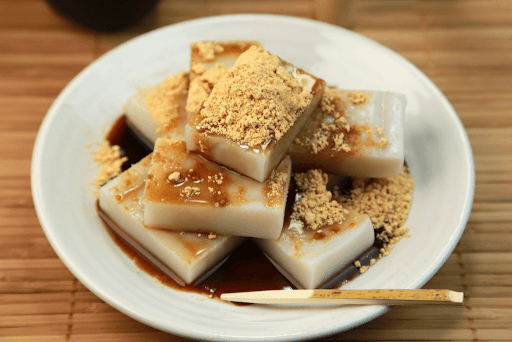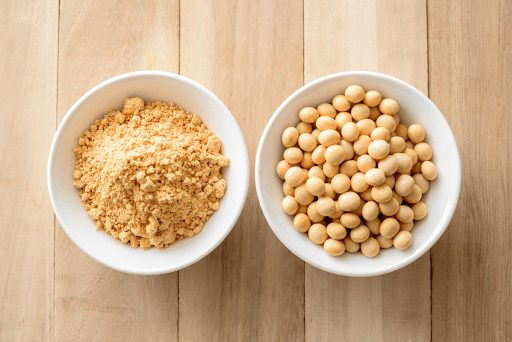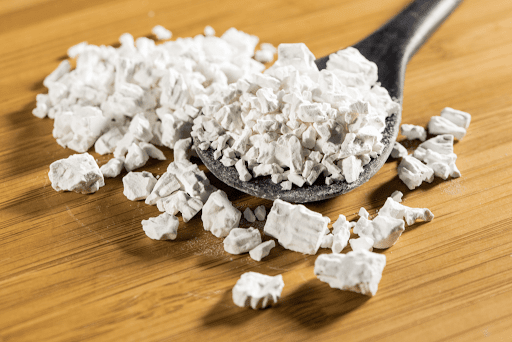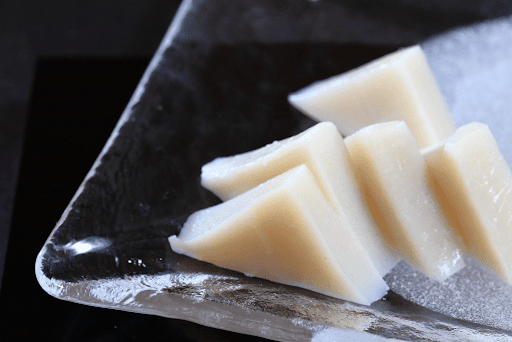kudzumochi, kuzumochi, mochi
Kuzumochi: The Mochi That Isn’t Mochi
Christian Closs
Posted on May 21, 2022
Share:

With Japanese mochi rice cakes becoming increasingly popular worldwide, the pleasantly chewy sweet has gained a large following. Mochi encasing a sweet filling, called daifuku, are particularly popular, but only represent the tip of the iceberg. Enter the little-known kuzumochi.
What is it?
Most importantly, kuzumochi is not mochi in the classic sense, as it does not actually contain any rice. If that was not confusing enough, the term also refers to several dishes.
These dishes all revolve around the same core dish: A jellylike block made by mixing a starchy powder with water and sugar. Firmer than jelly but similar in appearance, kuzumochi has a very, very light flavor, which is almost always complemented by brown sugar syrup and kinako, flour made from soybeans.
More so than its reserved taste, kuzumochi’s appeal is its cooling effect. Served with a cold drink, kuzumochi is the perfect dish for Japan’s hot and humid summer.

Kudzumochi vs. Kuzumochi
Most commonly, the term kuzumochi refers to a jelly-like dessert made with starch from the kudzu plant. The spelling kudzumochi and kuzumochi seem to be equally popular, but refer to the same dish. Found all over East Asia, the kudzu plant’s ground up roots are used as a starchy flour for a variety of dishes, usually as a thickener.
Interested in traditional Japanese snacks and sweets like kuzumochi? Why not try some for yourself? Sakuraco sends traditional Japanese snacks, tea and home goods, including kuzumochi, straight to your door.
Mixed with water and slowly heated, kudzu powder turns into slightly translucent kuzumochi. Not a ‘true mochi’ as it does not contain any rice, it instead offers a lightly textured dessert with easily adjustable sweetness. As true kuzumochi is both vegan and gluten-free, it is also a great alternative to standard mochi for those with dietary restrictions.

But Wait, There’s More
Different ways of spelling are not the only oddity with kuzumochi. There are also regional varieties completely devoid of kudzu powder, but instead involving fermentation. This makes kuzumochi the only fermented wagashi Japanese sweet there is.
The term can also refer to a specialty of Eastern Japan, made by fermenting wheat starch in lactic acid bacteria, usually for at least one year. The sour smell of fermentation is removed by a water rinse, with the starch then steamed to the desired texture and firmness. While different in taste, the two have practically the same appearance and are served in the same way: With roasted soybean flour and brown sugar.
So how can they be told apart? Mostly in writing. The characters used are different, with kudzu flour kuzumochi written 葛餅 and fermented wheat flour based kuzumochi written 久寿餅. The former is descriptive, combining the character for the kudzu plant with the character for the mochi rice cakes, while the latter relates to the fermented type’s origins.

Tasty, Lucky Finds
Fermented kuzumochi’s name relates to the name of its supposed discoverer, a Mr. Kyubei. About 150 years ago, a barrel of wheat flour outside of his house did not seal tight, with rain water entering inside. One day Mr. Kyubei found this barrel separated, as the fermentation process caused the flour to expand.
This initial barrel was discarded, but Kyubei decided to experiment with the converted starch to create a new kind of dessert. He presented it to the head of his neighborhood temple Kawasaki Daishi, who approved of it, and decided to name it. Using the first character of Mr. Kyubei’s name Ku and adding the auspicious character for long life zu, he dubbed it kuzumochi.
The city of Kawasaki just south of Tokyo is still a famous place to try the fermented version, with numerous tradition rich shops vying for customers.

Difference in Taste & Variety
Both types of kuzumochi have a very mild taste on their own, but connoisseurs swear by their favorites. Fermented kuzumochi only allows for adjustment through adjusting the fermentation or steaming time as its shelf life is a mere three days, but kuzumochi made with kudzu flour have plenty of options to add flavor.
Fruit flavors further enhance its refreshing character and make a popular addition to the hot weather sweet, but combinations with sweet anko bean paste are also popular.
We love kuzumochi (the non-fermented kind) and regularly feature it in our Sakuraco boxes. Have you tried it yet? What did you think? Would you also be interested in the fermented kind? Let us know in the comments below.

Discover authentic flavors with Sakuraco
Get Sakuraco 
2 Responses
I love kuzumochi! It has a nice texture and a gentle sweetness. The brown sugar kuzumochi was especially flavorful.

Discover authentic flavors with Sakuraco
Get Sakuraco 
Related Articles

Mochi: How is Mochitsuki Made in Japan?
Mochitsuki is the Japanese tradition of pounding steamed rice to make mochi for the New Year. Families and neighbors gather to participate in this lively and meaningful tradition. The teamwork involved helps everyone feel a sense of connection.

Konpeito Candy: What Makes This Starry Treat Shine?
If you are a fan of the famous Demon Slayer series, then you probably know that the favorite treat of the adorable Nezuko Kamado is those tiny, colorful little sweets.

Kinako: The Amazing Roasted Soybean Powder!
Kinako is a very popular ingredient that can easily be found in many traditional Japanese sweets. It has a distinctive flavor, standing alongside other classic tastes such as red bean or sesame. Let’s explore this charming ingredient together, and who knows, you might even be able to make it in your own beloved kitchen!

Aaron and Claire Make the Ultimate Japanese Pork Belly: Buta no Kakuni
If you want a Japanese dish that’s rich, tender, and simple to follow, Aaron and Claire show exactly how to make it in this episode. Aaron prepares Buta no Kakuni, a classic braised pork belly dish renowned for its rich flavor and tender texture.




Definitely would love to try the fermented kind of kuzumochi!